The Attributes panel displays the settings of a selected BPMN element. You can use the panel to manage the element's attributes. You can also drag & drop attributes from the panel to the pane to display them in the diagram. If you use the panel preset, the attributes panel is displayed in the middle of the left sidebar:

To return to the panel preset, go to the user preferences and use button Reset Panels.
Refer to Customizing Editors and Panels for detailed information about panel management in general.
The attributes of the BPMN model itself are shown if you click on the empty diagram pane:

The standard attributes for BPMN elements are:

-
Name
-
Description
Some elements have specific attributes:
-
Form (User Task)
-
Image (Image (BPMN))
-
Roles (Lane)
-
Sequence Flow Type (Relation)
-
Timeout (Timer Event)
-
Timer (Timer Start Event)
-
Trigger Events (User Task, Plain Event, Message Event)
Refer to Styling BPMN Elements for detailed informations about the styling options for BPMN elements.
Managing the Attributes' Content
In the attributes panel, all attributes of an element are displayed. Some standard attributes are used for all elements, while other attributes are only available for specific elements. Find below a list of all attributes.
Standard Attributes
|
Attribute Name |
Description |
Availability |
|---|---|---|
|
Name |

Click here to insert or change the Name of the related element. Generated elements (like e.g. message) cannot be renamed. |
All BPMN elements. |
|
Description |

If you want to insert a description for your element, click here to open a text editor where you can enter and format your text: 
|
All BPMN elements. |
Specific Attributes
|
Attribute Name |
Description |
Availability |
|---|---|---|
|
Form |
Attribute Form is only available for the element User Task. Use the selection list to assign a form to the user task. All forms you have created within the same service are displayed in the list: 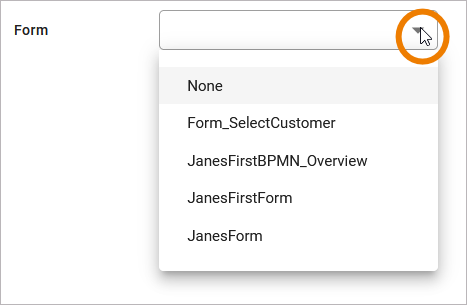
Once you have selected a form, an icon appears. It allows you to open the selected form directly: Refer to chapter Modeling Forms for further information about the creation of forms. |
|
|
Image |

It is possible to create images on the diagram pane. Use element Image (BPMN) from the elements toolbar. Once created, use the element’s attribute Image to upload a picture into the empty frame or insert a link to an existing picture. Use option X to delete the field content. |
|
|
Roles
|

Attribute Roles is only available for the element Lane. Click Open role editor to assign different roles to the lane. The number of roles assigned to a lane is then displayed in the attributes panel. |
|
|
Sequence Flow Type |
Attribute Sequence Flow Type is only available for the element Relation. Most relations can only be of regular type. In these cases the sequence flow type Regular is displayed in read-only mode. There is one exception for outgoing flows of exclusive gateways:

|
|
|
Timeout |
Attribute Timeout is only available for the Timer Event. To set the duration of the timer, the event should be trigged by a persisted property of type integer or datetime. You have two options to set the timeout in the attributes panel:
|
|
|
Timer |
Attribute Timer is only available for the Timer Start Event. To define the timer settings, click Open Timer to open the timer editor. For detailed explanations see How to Use the Scheduler/Timer. 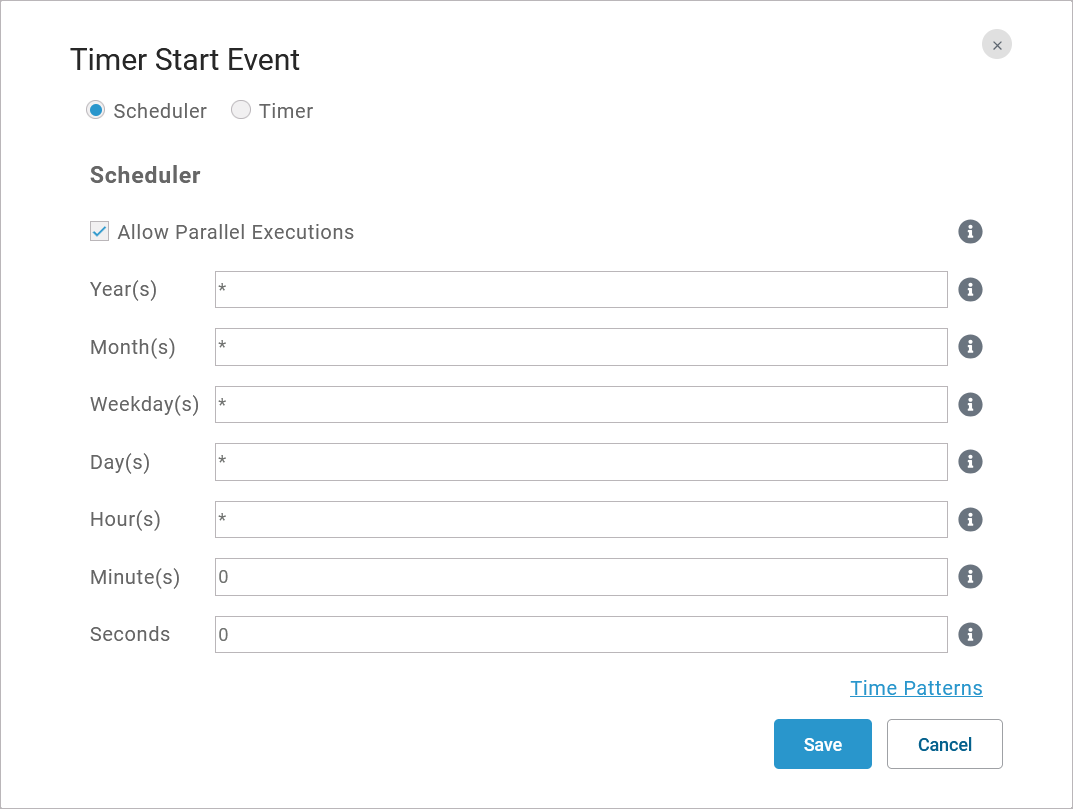
|
|
|
Trigger Events
|
Attribute Trigger Events is only available for the elements Message Event and Plain Event (as a boundary event) and for the element User Task. Use the selection list to assign which event triggers the default process flow of a BPMN process. Use the filter to search for a specific event: 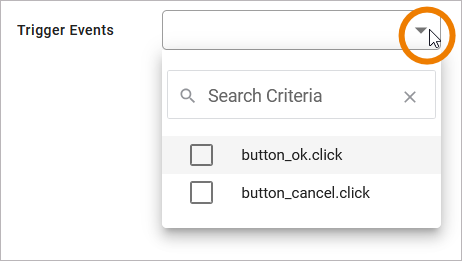
|
How to Use the Scheduler/Timer
If you use option Open Timer in the attribute panel, a separate editor will open where you can define the settings of your Timer Start Event. You have two options with different settings:
-
Scheduler (see below)
-
Timer (see below)

Scheduler
Use the scheduler if you want to define a pattern for your Timer Start Event, for example to start the model every monday, every hour etc.

|
Setting |
Description |
Default |
|---|---|---|
|
Allow Parallel Executions |
If checked, each time a scheduler pattern matches, the scheduler activity diagram is executed - even if another execution is already running.
|
Checked |
|
Year(s) |
Insert a positive integer or a pattern. |
* |
|
Month(s) |
Use numbers 1 to 12 or a pattern. |
* |
|
Weekdays(s) |
Valid input:
|
* |
|
Day(s) |
Depending on the month, valid input are numbers from 1 to 31 or a pattern. |
* |
|
Hours(s) |
Use 0 to 23 or a pattern. |
* |
|
Minute(s) |
Use 0 to 59 or a pattern. |
0 |
|
Seconds |
Use 0 to 59 or a pattern. |
0 |
Timer
Select the timer if you want to define a cycle for example to start the model after one week, after two hours etc.
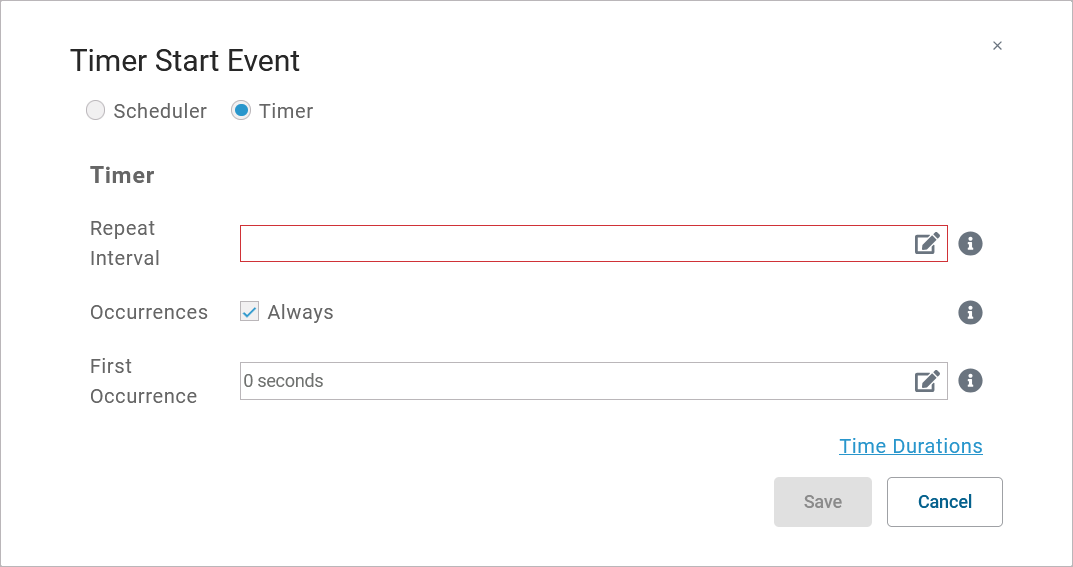
|
Setting |
Description |
Default |
|---|---|---|
|
Repeat Interval |
Enter a valid time duration expression (see below). Refer to Time Durations for detailed information.
|
- |
|
Occurences |
Insert a positive integer to define the count of repetitions. If you want the timer to be endless, check Always (default). |
Always |
|
First Occurence |
Enter a valid time duration expression (see below). Refer to Time Durations for detailed information.
|
0 seconds |
Duration Expression Wizard
The settings Repeat Interval and First Occurrence contain option Edit. Click this option to open a wizard that supports you to define the necessary duration expression:
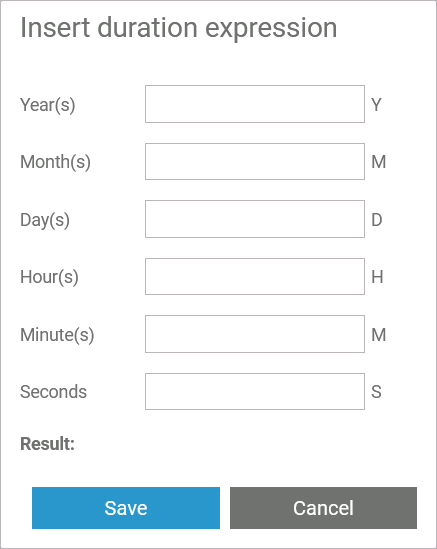
Insert positive integers in the desired fields. The result is shown below. Click Save to close the wizard:
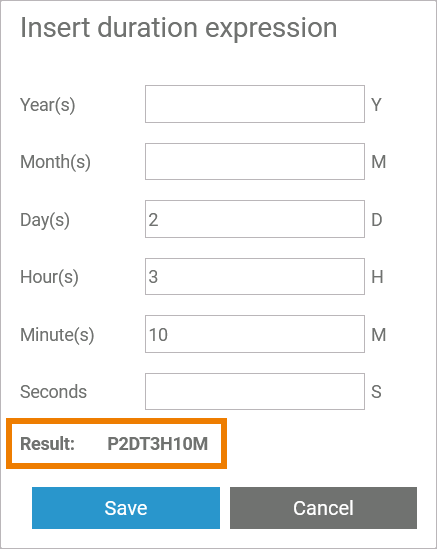
The duration expression is displayed in the corresponding field:

Once you are familiar with the notation of the duration expression, you can also insert it directly in the field.






